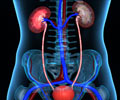Kidney injury that can arise after undergoing certain medical imaging procedures increases a patient's risk of having a stroke or heart attack over the next year or two
A study appearing in an upcoming issue of the Clinical Journal of the American Society Nephrology (CJASN)says that kidney injury that can arise after undergoing certain medical imaging procedures increases a patient's risk of having a stroke or heart attack over the next year or two.
The findings indicate that seemingly minor and reversible kidney damage from these common clinical procedures is a serious health threat.Medical imaging often uses contrast agents, substances such as iodine and barium that enhance the contrast of structures or fluids within the body. For example, contrast agents may be used during cardiac angiography and computed tomography procedures to visualize blood vessels and changes in tissues. Exposure to contrast agents can injure the kidneys, but patients are often told that this is only a temporary side effect. Recent research has suggested that such contrast-induced kidney damage may actually be more serious, although no thorough studies have looked into the hypothesis.
To investigate the issue, Richard Solomon, MD (University of Vermont), and his colleagues studied 294 patients with kidney disease who were exposed to contrast agents during cardiac angiography. Patients in the CARE (Cardiac Angiography in REnally Impaired Patients) trial were randomly divided to receive one of two contrast agents: iopamidol or iodixanol. After following patients for at least one year, the researchers found that 92 (31%) of the patients experienced negative health effects. Thirty-eight (13%) of the patients experienced a major event, such as death, stroke, heart attack, or end-stage renal disease. Individuals who developed contrast-induced kidney injuries had twice as many long-term negative health effects compared with patients whose kidneys were not damaged. In the absence of contrast-induced kidney injury, there was no difference in the incidence of long-term negative health effects between patients taking iopamidol or iodixanol. However, the investigators found that patients taking iopamidol had reduced incidences of both kidney damage and long-term negative effects. These parallel decreased incidences support the theory that contrast-induced kidney injury causes long-term negative effects.
The CARE trial findings should prompt investigators to design additional studies on the long-term negative health effects of contrast-induced kidney damage.
Source-Eurekalert
RAS









